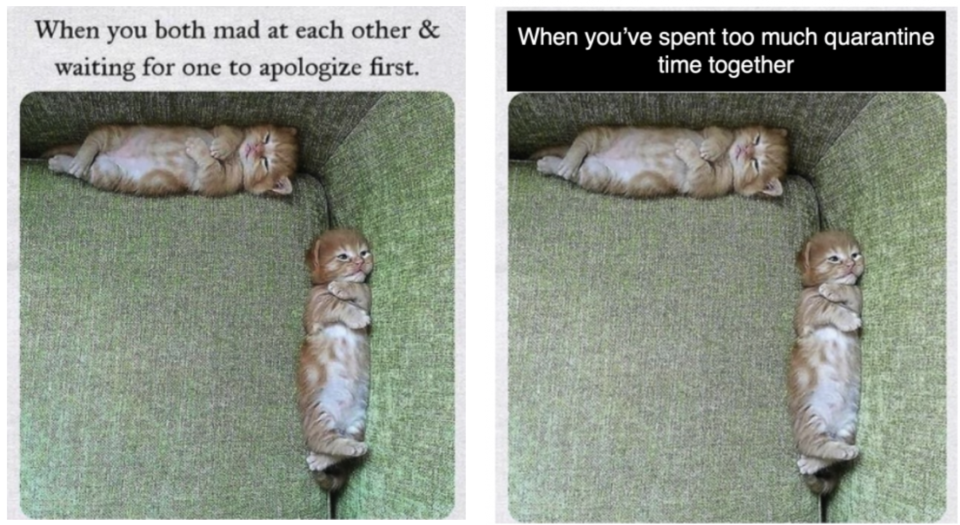What is a meme? They can be funny and cute or full of misinformation. We explain.
If you have spent any time scrolling through the internet, you have probably encountered a meme. From Grumpy Cat to Spider-Man pointing at another version of himself, memes are constantly being shared and altered over time.
Memes can be funny, satirical or cute. However, some memes can be dark and can potentially spread disinformation.
But what exactly is a meme? What do memes mean and how do they spread? Here's what you need to know.
Propaganda of the digital age: How memes are weaponized to spread disinformation
What is a meme?
According to Merriam-Webster, there are two definitions for meme:
"An amusing or interesting item (such as a captioned picture or video) or genre of items that is spread widely online especially through social media"
"An idea, behavior, style, or usage that spreads from person to person within a culture"
In general terms, memes can be anything, whether it be a video, image or GIF, that spreads and is repeated over time, becoming more entrenched within culture, said Mary Ingram-Waters, Ph.D., associate dean and professor at the University of Nevada-Reno Honors College.
"Memes have to be translatable within a particular demographic group — a group that has a shared language, shared meanings, shared culture," she explained. "Memes that really go viral, that really take off, can cross boundaries. So, they can be legible to lots of different kinds of groups."
A meme is an idea shortcut, triggering an understanding of something in multiple ways, said Ingram-Waters. For instance, an image of a dog making a side-eye glance can be utilized in a meme to call an idea or scenario into question or to denote suspicion.

Laughter is the best medicine: New study shows memes about COVID decrease stress
What does meme actually stand for?
The term "meme" was coined in 1976 by evolutionary biologist Richard Dawkins in his book, "The Selfish Gene." Along with memes comes memetics.
The word now is defined as "the study of memes" but memetics describes how ideas reproduce, change and evolve. Dawkins used "meme" to represent any piece of cultural information or content which operates via replication, alteration and mutation, surviving through dissemination.
As a result, memes are a cultural equivalent to a gene in the sense they are passed from person-to-person and can be the basis for an evolutionary process. Just as there are gene pools of different iterations and characteristics due to replication over time, there are meme pools based on the same principles.
In other words, memes are similar to viruses — they spread, replicate and make their way into facets of culture, leaving lasting impacts on history, similar to how viruses infect populations.
Just Curious: We're here to help with life's everyday questions
What is an example of a meme?
If it has a message or meaning behind it, anything can be a meme. A meme can include a video, image, text, GIF, among other mediums.
While you can use a popular image or person, such as Kim Kardashian yawning, you can use any random thing to make a meme. So long as the emotion and meaning behind the creation is recognizable and identifiable, you have made a meme, said Ingram-Waters.
The main key to a meme is its ability to be replicated. Take the woman yelling at the cat meme.
While the two images were not connected in the beginning, they come together to form a meme featuring former "Real Housewives of Beverly Hills" star Taylor Armstrong yelling at a white cat sitting in front of a plate of vegetables. Armstrong's facial expression denote anger and frustration, while the cat looks equally as bothered and unenthused.
These emotions drive the memetic nature of the image. People can insert whatever statement, phrase or saying into the meme so long as it relates back to the emotions displayed, making it resonate with a demographic.
"The woman who's upset and the cat who's staring at her in an accusatory way that can be recreated with other animals. It can be recreated with people," said Ingram-Waters. "You could rant. You can just put very random things in there. But that juxtaposition (of emotions) itself has become the memetic device."
Anything can act as a meme, all it needs is a relatability and the capability for revamping.
The Super Bowl halftime show reactions: See the best memes.
From Chuck Schumer to Stephen Breyer: Here are some viral memes from the State of the Union
This article originally appeared on USA TODAY: What is a meme? Meaning and history of the cultural phenomena


